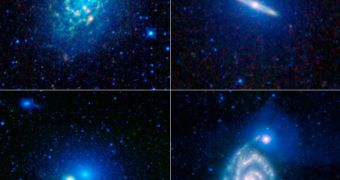In a new image meant to reveal the huge number of flavors galaxies come in throughout the Universe, scientists used data collected by the WISE telescope, which celebrated it's one year anniversary a couple of days ago.
The NASA Wide-field Infrared Survey Explorer spacecraft was launched on December 14, 2009, from Space Launch Complex 2 at the Vandenberg Air Force Base (VAFB), in California, aboard the Delta II 7320-10 delivery system.
The observatory carries four infrared sensors, capable of collecting high-resolution, highly-detailed data of a wide array of cosmic structures that are either too distant or too cold to be observed through other means.
Over the past year, it has discovered a wide variety of galaxies, some of which have been included in this collage, which celebrates the successful completion of its first 12 months in Earth's orbit.
Granted, WISE's main focus are asteroids, comets, and brown dwarfs, objects that are very difficult to discover and analyze with other types of telescopes. Still, that doesn't prevent mission controllers from observing the occasional galaxy.
Some of the most interesting cosmic structures it found range from star-studded spirals and bulging ellipticals to those paired with other companion galaxies, say experts at the NASA Jet Propulsion Laboratory (JPL), in Pasadena, California, who manage the mission.
The upper left panel of the new image features the textbook spiral galaxy NGC 300, while the upper right image shows Messier 104, also known as the Sombrero galaxy. It is also a spiral galaxy, but it looks different than NGC 300 on account of the fact that it has numerous stellar nurseries within.
The lower left pane contains the bulge galaxy Messier 60. The object is located in the Virgo Cluster, and is estimated to be some 20 percent larger than our own galaxy, the Milky Way.
In the lower right panel, JPL experts place an image of NGC 5194 (Messier 51), which is known better as the Whirlpool galaxy. Right next to the “grand design” spiral galaxy is NGC 5195, its companion.
These are just a few examples of WISE's resolving power. The mission is over since October 2010, and NASA got no additional funding to support it further.
However, the NASA Planetary division stepped in with funding for a shorter one month mission extension called NEOWISE, to search for small solar system bodies close to Earth's orbit.
JPL manages and operates the Wide-field Infrared Survey Explorer for NASA's Science Mission Directorate, Washington. The mission was competitively selected under NASA's Explorers Program managed by the Goddard Space Flight Center, in Greenbelt, Maryland.

 14 DAY TRIAL //
14 DAY TRIAL //